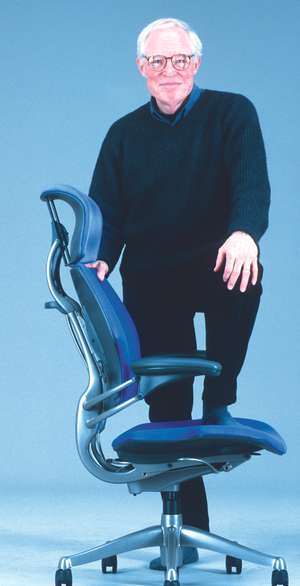If you are sitting in a very comfortable chair, you may owe your good fortune to designer Niels Diffrient, who died on June 8 at age 84 after a brief illness. Forbes magazine once called him “the granddaddy of ergonomic design.” He was that and so much more—the co-author with Alvin R. Tilley and Joan Bardagjy of a series of books called Humanscale 1-9, the designer of the Humanscale Freedom and Liberty chairs, Sunar Hauserman’s Helena and Jefferson Chairs, and Knoll Diffrient Chairs as well as of John Deere tractors, Trimline telephones, cockpits and truck cabs, and American Airlines graphics. He was also the author of a recent autobiography, Confessions of a Generalist, a speaker at TED conferences, and the recipient of 24 major national and international design awards.
 |
| Photo © Sally Andersen Bruce Niels Diffrient with his Freedom chair. |
Diffrient was born in rural Mississippi in 1928 and grew up in Detroit. He attended Cass Technical High School and Wayne State University and then graduated from Cranbrook Academy of Art where he studied painting and architecture. When he was still a student, he worked for Eero Saarinen while the architect was designing the Womb Chair for Knoll International. Upon graduation, on a Fulbright Scholarship in Milan, Diffrient met Domus magazine editor Gio Ponti, Memphis Group founder Ettore Sottsass, and Marco Zanuso, with whom he designed a Borletti sewing machine.
When he returned to the United States, he joined the Los Angeles studio of vanguard industrial designer Henry Dreyfuss, which had an impressive roster of corporate clients, and taught at UCLA. In the early 1980s, Diffrient opened his own consultancy and developed designs for Knoll International, Sunar Hauserman, Howe Furniture, KI International, and the Humanscale Corporation. He shared a studio with his wife, the Swedish tapestry designer Helena Hernmarck, next to their home in rural Ridgefield, Connecticut.
Diffrient was a pioneer in designing chairs “from the inside out” as architects like to say. He used X-rays to learn how human spines bent in seated positions, and he based his chair designs on how people actually sit—or ought to. Although he owned some classic modern chairs that had been designed, he thought, for visual affect, he said he never sat in them. He preferred to sit in a comfortable chair and look at them, instead.
Frustrated by supposedly ergonomic chairs with an array of knobs and levers that the user has to twist and turn, he asked, “Why should you have to read a 20-page manual to know how to run a chair?” His quest to create workplace environments fitted to the needs of their users reached an apex with introduction of the Freedom, a task chair for Humanscale that senses the weight of the user and automatically adjusts to provide optimal support. Later, the smaller, more economical Liberty chair had many of the same features.
Diffrient was a man whose warmth and sense of humor influenced all of his work. It didn’t hurt that the designs were peppered with a critical eye and a willingness to take a different path when the well-worn one seemed cluttered.

Post a comment to this article
Report Abusive Comment